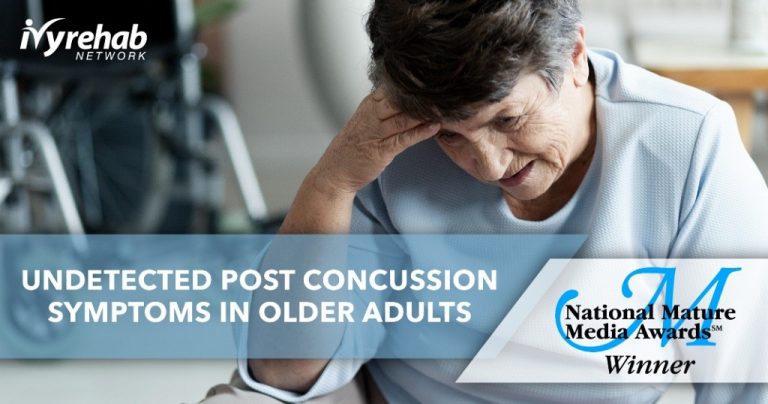
Undetected Post Concussion Symptoms in Older Adults
by Holly Lookabaugh-Deur, PT, DSc, GCS
Holly Lookabaugh-Deur is the Regional Director for Ivy Rehab Network Partner clinic, Generation Care located in West Michigan. Holly is a Board-Certified Geriatric Physical Therapist and a Certified Exercise Expert for Aging Adults. Holly is an award-winning writer, having earned a Best Medical Feature writing award for this article through the National Mature Media Awards. This article was originally published in Senior Perspectives.
Undetected Post Concussion Symptoms In Older Adults
Over the years, I have treated many older patients following a fall or fracture, and a recent case is a prime inspiration for this article. The importance of treating the WHOLE person and advocating for yourself and those you love is so very important.
My story is about an 84-year-old woman who lives alone, fell changing a light bulb, and fractured her hip. Following surgery, she struggled with some post-anesthesia fogginess – very common, very normal, and doesn’t mean you have dementia – and was placed in a skilled nursing facility. She didn’t bounce back as she had hoped and continued to struggle with dizziness, balance, headache, and generally not-feeling-good, although the hip was healing great. She didn’t like the food, lost some weight, and because she was unsteady, she was in a wheelchair more than she was out. So, a vibrant woman who cared for herself, her home, her yard, her grandchildren, and drove everywhere, is now on a downward spiral.
The Untreated and Undetected Complications
She went home with 24-hour care about a month later. A friend of a friend who saw the dramatic change in her called me and asked me to see her. When she started to tell me how she fell and how different she felt, something didn’t add up. After conducting a head to toe assessment, I discovered that she had 2 significant undetected/untreated complications of her fall, likely due to a blow to the head and concussion.
First, her cervical (neck) area had alignment issues, severe muscle spasms, and movement restriction – to the level that she certainly showed signed and symptoms of cervicogenic dizziness. This is very treatable – often overlooked as a stiff, older neck – and in two treatments of manual physical therapy techniques, she was feeling “75% better.” The lift in her energy level was incredible.
The second significant issue was her intermittent dizziness. This is NOT a normal part of aging. Dizziness is one of the top 5 chronic complaints of older adults, and its sources are varied and complex – medication, low blood pressure, inner ear issues, and more. In this case, because of her fall and a slight bump to the side of her head without loss of consciousness, I suspected that she may be suffering from “benign paroxysmal positional vertigo” or “BPPV” as it is nicknamed.
Sure enough, testing that only took 5-10 minutes showed a positive response. BPPV is a condition where tiny little crystals in the semicircular canals of the inner ear – are bumped into the wrong canal. The semicircular canals keep our head and body in balance in space, sending signals to the brain about our position. When these crystals fall into the wrong canal, the visual system, a critical part of how we sense our balance, and the inner ear are sending two different signals to the brain, and sometimes the result is a dizzy or woozy feeling, even for a few seconds. In my patient’s case, she was suffering from this for 6 weeks, causing her stomach to be upset, impacting her diet, and her spontaneous will to move and be active. She was very fearful of falling, and this also contributed to her decline inactivity. BPPV can be treated in ONE treatment, moving the head in certain positions to get crystals (otoliths) back where they belong. It is a game-changer!
Since finding two specific sources of her ongoing symptoms, I am happy to report that within a week – just two treatments and some homework – this wonderful lady began to feel so much better, her decline quickly turned into an INCLINE, and she is almost completely done using her walker. She has a cane for long walks, but at 10 weeks post-fracture, the other problems are resolving and she sees a brighter future. She is committed to her ongoing work of strengthening, balance progression, breathing, and eye exercises, and I am fully confident I will once again see her swinging a golf club, holding her new great-grandchild, and living her life to its fullest potential.
My message? Don’t accept feeling badly as a “normal” part of aging. Keep asking questions. Seek help. And never give up!
Article Reviewed by Holly Lookabaugh-Deur, PT, DSc, GCS, CEEAA
Holly Lookabaugh-Deur, PT, DSc, GCS, CEEAA is a practicing physical therapist and a partner and Director of Clinical Services at Ivy Rehab Network. Deur is board certified as a geriatric clinical specialist and certified exercise expert for aging adults with more than 35 years of clinical experience. She is certified as an aquatic and oncology rehabilitation specialist and serves as adjunct faculty at Central Michigan University and Grand Valley State University.
The medical information contained herein is provided as an information resource only, and does not substitute professional medical advice or consultation with healthcare professionals. This information is not intended to be patient education, does not create any patient-provider relationship, and should not be used as a substitute for professional diagnosis, treatment or medical advice. Please consult with your healthcare provider before making any healthcare decisions or for guidance about a specific medical condition. If you think you have a medical emergency, call your doctor or 911 immediately. IvyRehab Network, Inc. disclaims any and all responsibility, and shall have no liability, for any damages, loss, injury or liability whatsoever suffered as a result of your reliance on the information contained herein.